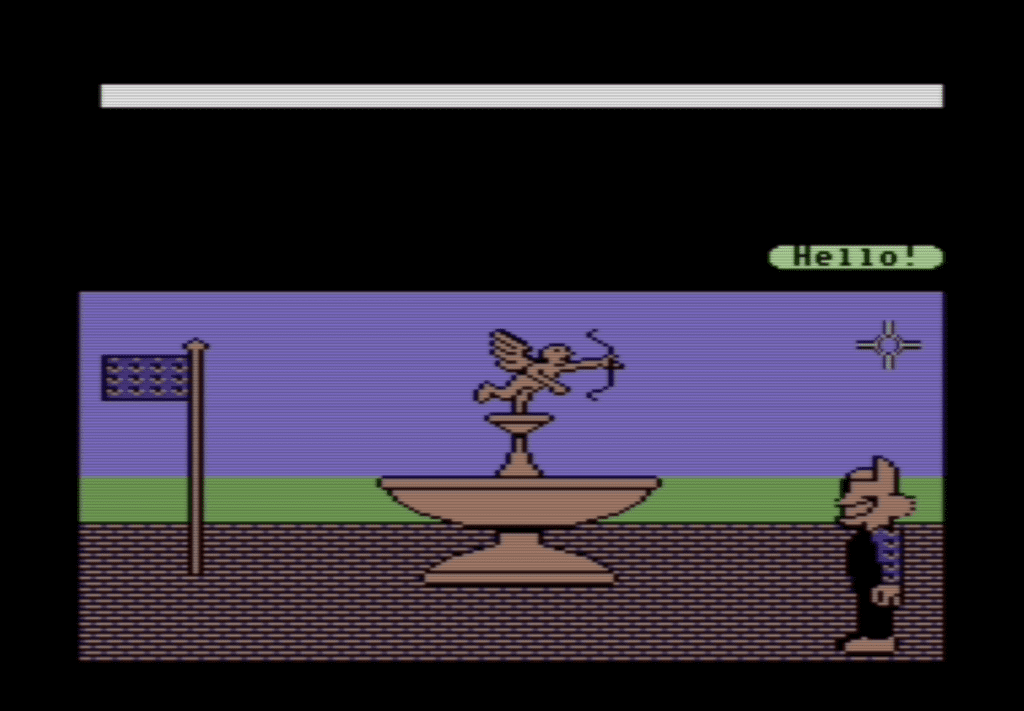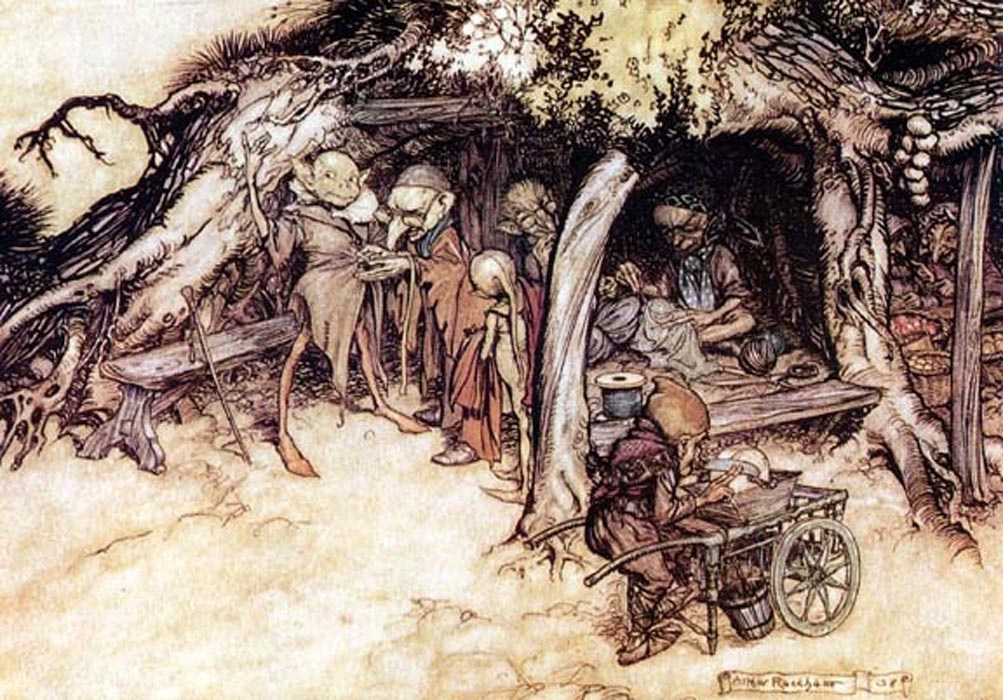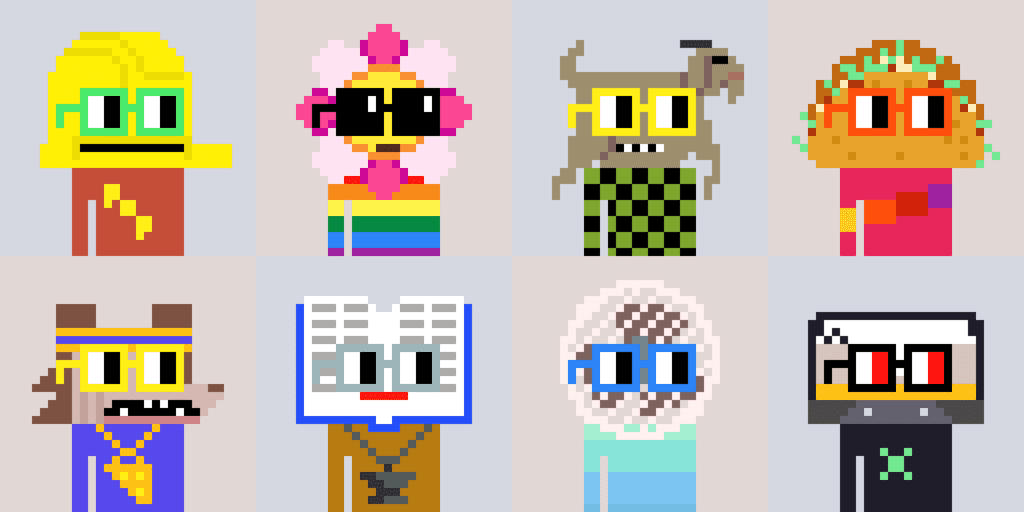In 1986, the early internet provider Quantum Link and the entertainment company Lucasfilm Games released what might be considered the first ever MMO: a social, avatar-based world called Habitat, which could be accessed via a 300-baud modem ($0.08 per minute) and a user’s Commodore 64 ($595, or roughly $1,670 in today’s terms). Habitat was a departure from text-based MUD games (which were multiplayer but lacked graphics) and free-ranging USENET forums (which of course were text-based but lacked formalized gameplay) that dominated the early net-connected market at the time.

In short, Habitat was a virtual civilization, with real-time player chat, trading, and interaction. Habitat was also arguably a forebear of what the now-contested (both definitionally and territorially) “metaverse” may one day become.
In a reflection on Habitat, published a few years after its launch, developers Chip Morningstar and F. Randall Farmer described the complexity of a world with an emergent form of politics, economy, and user-generated content. Habitat looked and felt different: a universe which grew to over 20000 regions, including player homes, shops, arenas, theaters, newspapers, houses of workshop, and a “wilderness” area where crimes like theft and murder could be committed (a practice which a Greek Orthodox priest, who led one of Habitat’s aforementioned houses of worship, preached vehemently against in his digital “Order of the Holy Walnut” church).
There were stories of in-game currency arbitrage related to a bug that allowed a few enterprising players to buy underpriced game items from an ATM, and sell them at a higher price in a shop across town — resulting in the printing of hundreds of thousands of in-game tokens overnight. There were in-game, developer-created treasure hunts and user-created business ventures. The entire reflection on Habitat has an air of novelty and lawlessness. Even the internet standards Habitat was built upon would cease to exist within a few years: OSI, whose “presentation” and “application” layers Morningstar and Farmer complained were “simply the wrong abstractions for the higher levels of a cyberspace communications protocol”, was beat out a few years later by the simpler TCP/IP internet standard upon which the net lives today.
These early tensions might be best summed up by the header of the Morningstar and Farmer reflection on the Habitat experiment: “Detailed central planning is impossible; don’t even try.” Indeed, one takeaway from Habitat that we can apply to the internet today is that top-down attempts to impose order are almost always undermined by acts of subversion, or the natural phenomenon of the free market prevailing.
I first learned about Habitat in Virtual Society, an upcoming book on the metaverse by Herman Narula, the co-founder and CEO of Improbable, a company that has been in the business of building infrastructure for games, digital experiences, and now the metaverse for the past decade. Narula’s main argument about the metaverse is one that Morningstar and Farmer would likely agree with: The metaverse, regardless of who builds it, how users access it, or the underlying infrastructure that supports it, should be designed to facilitate robust forms of user interaction.
Just as importantly (though not addressed by Morningstar and Farmer), is the idea that items and experiences across the different virtual worlds that grow to exist should be able to interoperate with one another. In Narula’s words:
“A metaverse is a collection of realities which include the real world or a ‘home reality’ and a series of other worlds that a society imbues with meaning. Events, objects, and identities can exist in and be modified by multiple worlds in the metaverse. The utility of a metaverse lies in its ability to facilitate meaningful fulfilling experiences in its constituent worlds.”
Many arguments about the metaverse have hinged on what it looks like: Should it be 2D or 3D? Should it be accessed immersively in VR and AR, or is desktop and mobile an appropriate platform?
The focus on aesthetics is actually a debate about standards. “What should it look like” is shorthand for “what should developers expect?” How do you reconcile between JSON and XML data types? If you’re designing for 3D, what’s the minimum number of polygons your asset should be composed of? Should avatars be available as glTF, USD, VRM, or some other file format? Should an experience happening on a Unity client be able to interoperate with a game on an Unreal Engine client? What happens when you introduce NFTs into the mix (or if you’re Microsoft, what happens when you make a unilateral decision to ban them completely from Minecraft with seemingly no warning)?
I think these questions are tremendously valuable, in that they signal an attitude of openness toward interoperability that’s crucial for any future version of the metaverse. But it also seems like the aesthetic and technical considerations are conflated, perhaps at the expense of economic or political considerations.
In the words of Narula, “These other worlds aren’t alternative realities into which we choose to escape: They are more reality.”
How do you facilitate “more reality”? Is it even actively facilitated, or more organic — the outcome of unique cultural and economic factors across epochs? In the early chapters of Virtual Society, Narula traces the first instantiations of the “metaverse” back to the earliest ages of civilization — constructions like Göbekli Tepe, the Egyptian Pyramids, and ancient myths like the Icelandic Huldufólk (elves, basically) — which not only occupied the imaginations of past civilizations, but actually influenced the way society functioned, and continue to function, in the physical world.

For example, the idea of Huldufólk, Narula points out, has actually influenced modern-day conservation efforts in Iceland. As Narula puts it: “The mirror world helps catalyze conservationists’ efforts in the real world.” What Narula argues in the first few chapters of Virtual Society is that early metaverses had a sense of reciprocity between the “imagined” world and the real one. If you extend that notion to the present day, then we should have a similar ideal: whatever form the metaverse takes, there should be a sense of permeability between the virtual world and our physical one.
When something happens in the metaverse, you should feel its resonance in the physical world, and vice-versa.
Narula spends a lot of time in Virtual Society explaining how he defines meaningful interaction in the metaverse, and the technological innovations achieved by Improbable to enable it for users. For Narula, meaning might be measured in “ops per second”:
“how many separate and simultaneous things can happen in a virtual environment, by reflecting how many messages are being sent or need to be sent simultaneously to model that environment. As an example, at time of writing, a game of Fortnite which allows 100 players to interact together requires roughly 10,000 communications operations per second. This statistic means that the server needs to process all of these messages, and also to quickly send them to the machines of each connected user that needs them.”
This past summer, I attended a demo event in Improbable’s M² network, which the team intends to be a network of metaverses where users can connect in highly dense environments, and port in NFTs and other avatars between worlds. There were over 4500 users in attendance, all in the same server instance (in other words, no sharding!), speaking and interacting with one another. Over time, M² intends to grow to support not just the Otherside metaverse, but other creative endeavors as well: concerts with musicians, spaces for communities, events with artists and creators.
In many ways, the challenges M² aims to address — how to get a bunch of disparate users to agree on a shared notion of temporality — is also a core challenge that blockchains solve for. And in many ways, we’re also beginning to see blockchains, and the applications built on top of them, begin to solve other problems that have frustrated the internet and early attempts at the metaverse.
One way to think of a blockchain is as a game-like social network with an infinitely customizable frontend. Using Ethereum as an example: You have a public key as a form of login; opt-in identities tied to that public key (e.g. ENS, Farcaster); an inventory (NFTs, ERC20 tokens); applications accessible through your public key (e.g. Uniswap, NFT exchanges, on-chain games); and a shared notion of history (viewable on Etherscan or parseable on an Ethereum node).
Smart contracts running on Ethereum are open-source — meaning that users can audit them for safety, and just as importantly, modify them via forking. These modifications may extend the underlying codebase (e.g., a composable application that interacts with the smart contract, a new client or frontend built for the smart contract, or a derivative project based on the initial protocol). The more a smart contract is interacted with and extended, the more valuable it can become.
Some of the most interesting experiments in Ethereum today have been in fields that mix artistic, social, economic, political, and gameplay-like elements. A good example here is NounsDAO, which launched in the summer of last year. In brief, NounsDAO is an NFT project in which a daily auction is held for the sale of a Noun NFT, and proceeds of the sale go to a treasury shared by holders of the Nouns, who can vote on proposals for how the treasury is spent. Crucially, the auction protocol, the art, and the governance is all conducted entirely on-chain. Proposals funded by the DAO have proliferated the Nouns meme and ethos across the internet and the physical world — thanks primarily to the way the project has captivated the imagination of artists and developers.

On Ethereum, we’ve seen projects like a 3D Nouns generator, derivative auctions and projects funded through Prophouse (which was infrastructure funded with the Nouns treasury, but has now grown to support other NFT projects), and an effort to support multiple developers building alternative clients for Nouns. In the physical world, we’ve seen the creation of luxury Nouns glasses, Nouns-branded coffee, and many IRL activations. In addition, other projects using the Nouns codebase have spawned without any backing from the NounsDAO treasury at all: examples include Public Nouns, a fork of NounsDAO, which uses its treasury to fund projects in the public goods space; and other projects like Lil Nouns, Nounlets, and nouns.build. A comprehensive, though incomplete, collection of 157 derivative Nouns projects can be perused here.
Many things are worth pulling at in more detail: The 3D Nouns generator, for example, is open-source and available in GLTF, OBJ, and VOX file formats — an illustration that the file-format question can be solved for naturally by independent developers, and leveraged by users who have the freedom to port those assets anywhere. The effort to develop alternative clients for NounsDAO is a testament to the notion that a protocol should be resilient, and offer users a breadth of choices for how they access it. The success of the NFT project itself is just one example of the prevalence of cc0 NFT collections in general — that an image in the metaverse should be freely forked, mutated, and be enjoyed by anyone who desires to use it.
Although the project, cryptonetworks, and the metaverse itself are still in early forms, I think NounsDAO represents a compelling example of what elements of the metaverse one day might look like: a robust ecosystem around a core ethos or culture, that persists across both the digital and physical worlds.
A big irony I’ve noticed in the corporate-motivated efforts behind the metaverse is that these teams are often building for massive brands that predated the internet. It feels like an effort to rebuild digital society as if the social ruptures and micro-cultures manifested by the internet never happened (a pretty futile act in my opinion). One thing Narula hints at — that I don’t see a lot of people talking about — is that those most inclined to build on metaverse platforms (be it Ethereum, other blockchains, or platforms that prioritize interoperable experiences) will likely be internet-native communities and creators, with treasuries that they want to preserve for developing their own culture. In Narula’s words:
“In order for a metaverse to populate with the quantity and quality of worlds and experiences necessary for it to be worth anyone’s time, then, it will have to resemble an inverted pyramid, where the infrastructure providers take the smallest percentage of value, and the rest of the value is created by and accrues to the creators.”
Decentralized blockchains eliminate middlemen. We live in an era of 30% app store take rates, opaque algorithms, and where an increasingly high volume of content competes for an ever-dividing audience for attention. An outsize amount of the value created on these networks gets siphoned away by the platforms themselves, and a similar degree of uncertainty abounds when it comes to the terms, services, and standards permitted by these platforms.
What blockchains — and the smart contracts that run on them — provide is a platform that is minimally-extractive: If you compare aggregate gas fees on Ethereum to the aggregate amount of value transacted on-chain, the blockchain’s take-rate comes out to around 0.05%. This amount will likely fall in the coming years, as scaling solutions get more adoption, and more layer one chains launch.
Additionally, most blockchain applications have far lower take-rates than their web2 corollaries. And given that decentralized blockchains are computers that can make commitments, developers and users have an incentive to build in, and enrich, a robust ecosystem that stems from the strong guarantee that the smart contracts they interact with will not suddenly change.
Earlier this year, Arianna Simpson, Eddy Lazzarin, and Liz Harkavy on our team published a piece on the “7 Essential Ingredients of a Metaverse”. In our characterization of the metaverse, we felt it was vital that “[a]n open metaverse is decentralized, allows users to control identity, enforces property rights, aligns incentives, and ensures value accrues to users (not platforms).”
With this in mind, it’s less relevant whether the next generation of the internet is VR or AR, or on a desktop or mobile client. The metaverse will need to facilitate meaningful interaction while also making immutable commitments to a user’s economic rights.
In Virtual Society, Narula lays out a compelling history of the human impulse to build worlds in which this is possible, and argues that if these worlds can’t interoperate, then we’ve hit a dead end. As an increasing number of people both make a living online, and build experiences exclusively for the digital realm, we need to continue to advocate for decentralization and openness. Or to quote Morningstar and Farmer: “Detailed central planning is impossible; don’t even try.”
Virtual Society: The metaverse and the new frontiers of human experience (Currency/ Penguin Random House, 2022) comes out on October 11 and is available for pre-order here.
image sources: Habitat; NounsDAO; Huldufólk
***
The views expressed here are those of the individual AH Capital Management, L.L.C. (“a16z”) personnel quoted and are not the views of a16z or its affiliates. Certain information contained in here has been obtained from third-party sources, including from portfolio companies of funds managed by a16z. While taken from sources believed to be reliable, a16z has not independently verified such information and makes no representations about the current or enduring accuracy of the information or its appropriateness for a given situation. In addition, this content may include third-party advertisements; a16z has not reviewed such advertisements and does not endorse any advertising content contained therein.
This content is provided for informational purposes only, and should not be relied upon as legal, business, investment, or tax advice. You should consult your own advisers as to those matters. References to any securities or digital assets are for illustrative purposes only, and do not constitute an investment recommendation or offer to provide investment advisory services. Furthermore, this content is not directed at nor intended for use by any investors or prospective investors, and may not under any circumstances be relied upon when making a decision to invest in any fund managed by a16z. (An offering to invest in an a16z fund will be made only by the private placement memorandum, subscription agreement, and other relevant documentation of any such fund and should be read in their entirety.) Any investments or portfolio companies mentioned, referred to, or described are not representative of all investments in vehicles managed by a16z, and there can be no assurance that the investments will be profitable or that other investments made in the future will have similar characteristics or results. A list of investments made by funds managed by Andreessen Horowitz (excluding investments for which the issuer has not provided permission for a16z to disclose publicly as well as unannounced investments in publicly traded digital assets) is available at https://a16z.com/investments/.
Charts and graphs provided within are for informational purposes solely and should not be relied upon when making any investment decision. Past performance is not indicative of future results. The content speaks only as of the date indicated. Any projections, estimates, forecasts, targets, prospects, and/or opinions expressed in these materials are subject to change without notice and may differ or be contrary to opinions expressed by others. Please see https://a16z.com/disclosures for additional important information.



